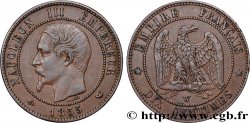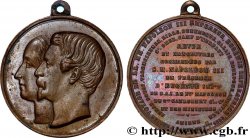fme_998317 - SECOND EMPIRE Médaille, Souvenir de l’exposition universelle
недоступный.
Товар уже продан в нашем интернет-магазине (2025)
Цена: : 32.00 €
Товар уже продан в нашем интернет-магазине (2025)
Цена: : 32.00 €
Тип Médaille, Souvenir de l’exposition universelle
Дата: 1867
Металл: brass
Диаметр: 27 mm
Ориентация осей монеты: 12 h.
Вес: 6,82 g.
Век: lisse
Пуансон: sans poinçon
Комментарии о состоянии
Traces d’oxydations, de rayures, petites taches noires, patine irisé avec une partie de son brillant de frappe
Лицевая сторона
Аверс: легенда: NAPOLEON III EMPEREUR EUGENIE IMPERATRICE.
Аверс: описание: Têtes de Napoléon III et d’Eugénie.
Обратная сторона
Реверс: легенда: EXPOSITION UNIVERSELLE / 1867.
Реверс: Описание: Pavillon de l’exposition avec des drapeaux..
Комментарий
L'Exposition universelle de 1867, également appelée Exposition universelle d'art et d'industrie, est chronologiquement la septième Exposition universelle et la seconde se déroulant à Paris après celle de 1855. Elle s'est tenue du 1er avril au 3 novembre 1867 sur le Champ-de-Mars, à Paris. 41 pays étaient représentés à l'Exposition...
Cette médaille n’est pas signée et n’est pas non plus attribuée
Ce type d’avers a été utilisé en diverses occasions en 1867 surtout pour la médaille de souvenir de l’Exposition mais aussi par exemple pour l’inauguration de la ligne de train Fougères / Vire.
Il existe deux types de droit, selon qu’il y ait ou non la légende circulaire autour des 3 médaillons..
The 1867 World's Fair, also known as the World's Fair of Art and Industry, is chronologically the seventh World's Fair and the second to take place in Paris after that of 1855. It was held from April 1 to November 3, 1867 on the Champ-de-Mars in Paris. 41 countries were represented at the Exposition... This medal is not signed and is not attributed This type of obverse was used on various occasions in 1867, especially for the souvenir medal of the Exposition but also, for example, for the inauguration of the Fougères / Vire train line. There are two types of rights, depending on whether or not there is the circular legend around the 3 medallions.
Cette médaille n’est pas signée et n’est pas non plus attribuée
Ce type d’avers a été utilisé en diverses occasions en 1867 surtout pour la médaille de souvenir de l’Exposition mais aussi par exemple pour l’inauguration de la ligne de train Fougères / Vire.
Il existe deux types de droit, selon qu’il y ait ou non la légende circulaire autour des 3 médaillons..
The 1867 World's Fair, also known as the World's Fair of Art and Industry, is chronologically the seventh World's Fair and the second to take place in Paris after that of 1855. It was held from April 1 to November 3, 1867 on the Champ-de-Mars in Paris. 41 countries were represented at the Exposition... This medal is not signed and is not attributed This type of obverse was used on various occasions in 1867, especially for the souvenir medal of the Exposition but also, for example, for the inauguration of the Fougères / Vire train line. There are two types of rights, depending on whether or not there is the circular legend around the 3 medallions.








 Cообщить об ошибке
Cообщить об ошибке Распечатать страницу
Распечатать страницу Отправить мой выбор
Отправить мой выбор Задать вопрос
Задать вопрос Consign / sell
Consign / sell
 Информация
Информация











